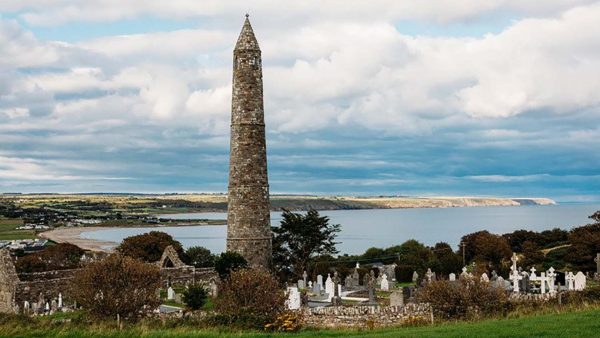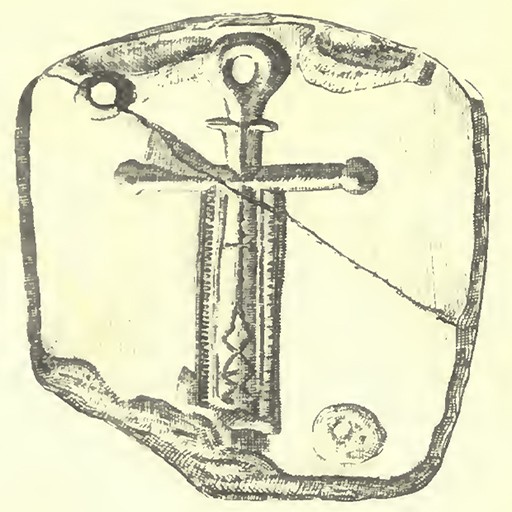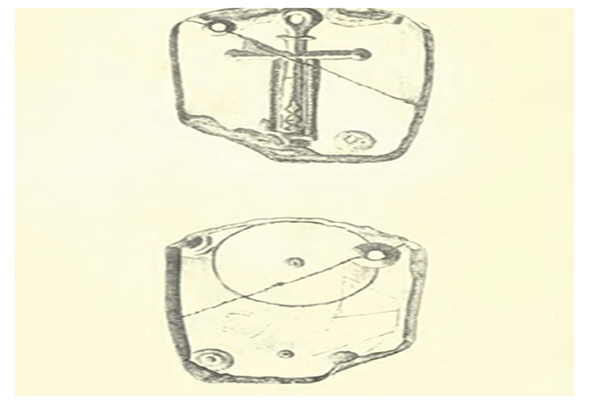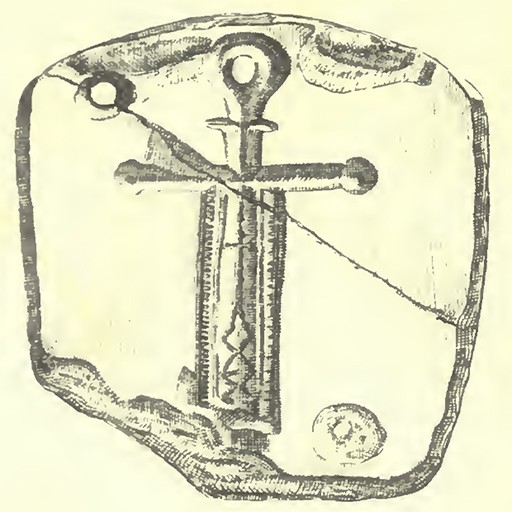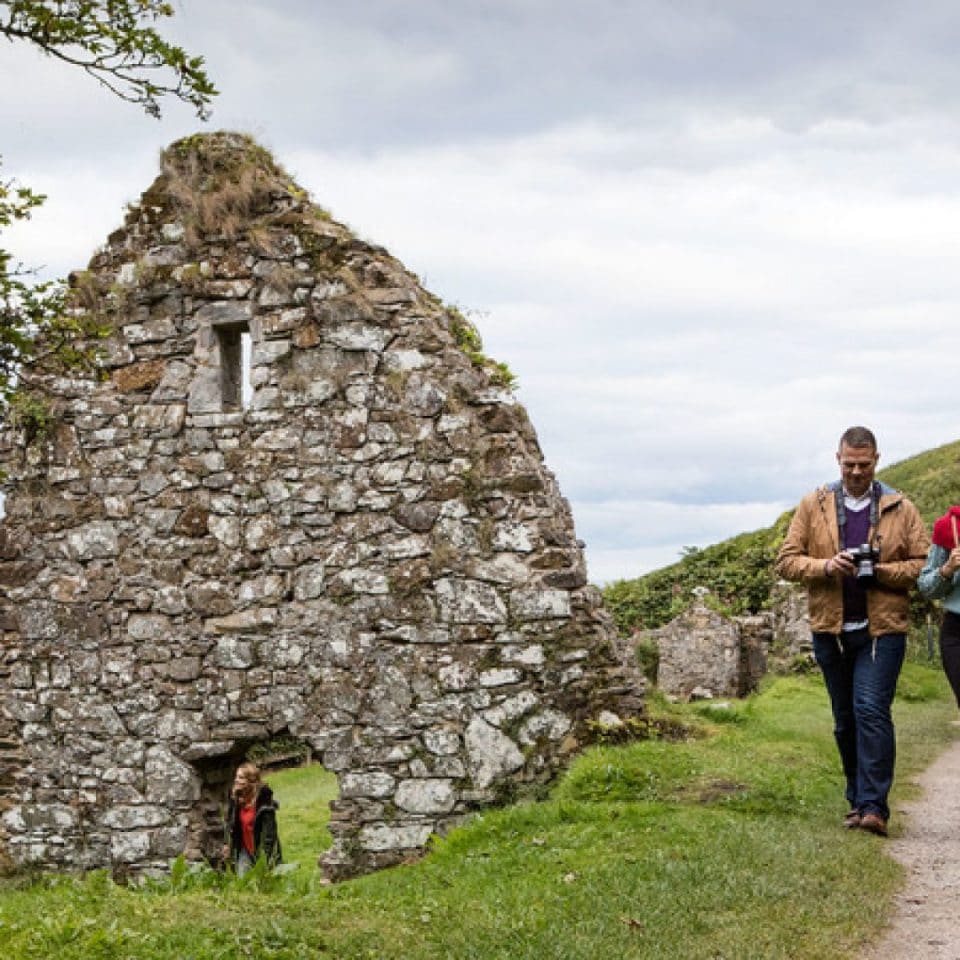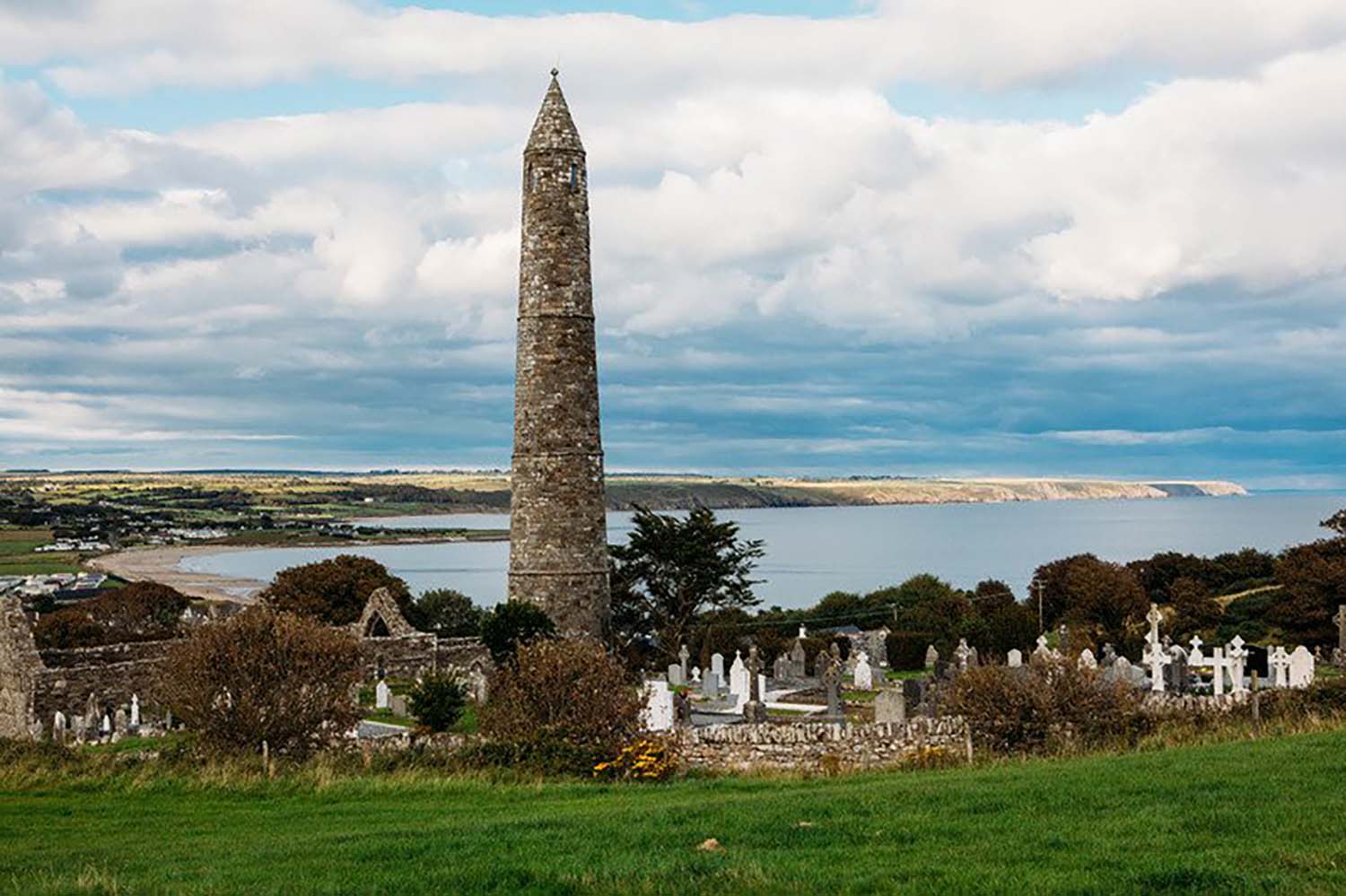Nestled among Ardmore’s awe-inspiring landmarks lies a tale of a forgotten treasure that once held immense spiritual significance. Join us on a journey through time as we uncover the enigmatic story of the Duivhin Deaglain, a sacred relic shrouded in mystery and miracle.
A Heavenly Gift
Legend has it that while St. Declan was celebrating mass in Italy, a small black stone miraculously appeared, descending from the heavens and landing on the altar. This divine gift, the Duivhin Deaglain (Declan’s Black Relic), became a powerful symbol of faith and a source of countless miracles.
A Relic Like No Other
The Duivhin Deaglain was no ordinary stone:
- Crafted from black marble, it bore an intricate incised cross
- Three mysterious holes adorned its surface, possibly once filled with precious metals
- Some accounts speak of a silver crucifix that once graced its face
A Journey of Faith
The relic’s voyage to Ireland is steeped in legend. When accidentally left behind on a rock in Italy, St. Declan prayed for its return. Miraculously, the rock itself began to float, carrying the precious stone across the sea to the shores of Ardmore.
A Legacy of Healing
For centuries, the Duivhin Deaglain was revered for its healing powers:
- It was said to cure sore eyes, headaches, and various ailments
- Pilgrims sought its touch, believing in its miraculous properties
The Mystery Deepens
As time passed, the relic’s story took unexpected turns:
- It was reportedly found in St. Declan’s grave within his oratory
- Theories emerged about its true purpose – was it an ancient seal? A mold for casting crosses?
- The relic changed hands, passing through generations of caretakers
A Treasure Lost
Today, the whereabouts of the Duivhin Deaglain remain unknown. Its disappearance adds another layer of intrigue to Ardmore’s rich tapestry of history and legend.
As you explore Ardmore’s ancient sites, from the Round Tower to St. Declan’s Well, remember the tale of the Duivhin Deaglain. Perhaps, like the miraculous floating rock that brought it to Ireland’s shores, this sacred relic will one day resurface, ready to share its secrets with a new generation of believers and history enthusiasts.
Will you be the one to unravel the mystery of Ardmore’s lost relic?
Citations:
[1] https://www.ardmorewaterford.com/duivhin-deaglain-a-lost-relic-of-ardmore/
We include an alternate account for those interested in some more details.
Whatever part of Ardmore you love, you’ll find yourself within walking distance of some of our awe-inspiring landmarks.
From a Cathedral to a Round Tower on a hill to a Saints Well and Stone to a what has been described as a folly on a Cliff walk, all make Ardmore a location of special interest on Ireland’s Ancient East Trail.
Each has a special story.
But, we must also discuss a heritage relic that has been lost. A relic that has also been forgotten by many but which still poses a mystery. Relics are an important part of religions around the world. And, the word relic comes from the Latin term for “remains”.
The relic we want to talk about is known as the Duivhin Deaglain and we present a wonderful account of it from The Journal Of The Kilkenny & South East Of Ireland Archaeological Society, Vol. III, (1860-1861)
THE DUIVHIN DEAGLAIN
With respect to our other relic, lately identified as the “Duivhin Deaglain” forming the illustration to this paper, I received the following note over three years ago from Mr. Williams, before either he or I was aware that there was any mention made of it in the ” Life of St. Declan.” Writing to me on another subject, date 20th November 1856, he says :
” I have before me a little relic of St. Declan, which goes under the name ‘ Dhuveen’ (probably a corruption of tub, black, and Thron, a relic): it is formed of black marble, and bears an incised cross on the face, which, within the memory of the present owner, contained a beautifully executed silver crucifix. It has been found in St. Declan’s grave, and long used to cure sore eyes, headache, &c., &c. The present owner,
Mr. John Burke, of this town (Dungarvan), lent it some time ago to an Irish Goth for that purpose, who took away the silver figure, and otherwise greatly mutilated it; there is an iron band around it to keep it together. I expect to be able in a few days to get in its history. I enclose a full-sized sketch of it; the three holes are countersunk, doubtless for the purpose of holding some metal, as one hole is filled with lead, which has an iron pin in its centre, that appears at both sides; it is likely the other two were filled in the same manner.”
The above letter layover among my papers since. I ought to mention here, that when I had taken away the MS. c< Life of St. Declan” from my first translator, Mr. Williams kindly offered to take up the matter, and complete the translation; the genealogy is given herewith, and the following extracts relative to the “Duivhin, “are from his pen. About three months ago he wrote to me, saying, that he was much pleased to find, in reading over the MS., that the Duivhin was mentioned several times in it. I immediately wrote, saying, if possible, we should get possession of the relic for examination, &c. ; but, to my great disappointment, he informed me, in a post or two, that he had made every inquiry, and found that the owner of it was dead some time, and his wife was dead, and no one could give him any information what had become of it. I again urged him to persevere, saying, such a matter would not be lightly destroyed by the peasantry, and that we should get it. He did persevere, and with success, for a part of a letter from him, dated 15th December 1859, ran thus :
” I am glad to inform you that St. Dedans affairs look a little brighter this morning; I was speaking two days ago to the present possessor of the ‘Duvveen; he lives about ten miles from this, but promises to be in town before a week when he would bring it to me for a short time.” About a month ago the relic was brought, and lent to him for a short period; he immediately forwarded it to me, and I made the accompanying sketch and took several impressions from it in wax (one of which I send for the Society’s Museum). I returned the relic, and understand that it is still in the possession of Mr. Williams. The portions of the ” Life” which refer to this remarkable relic are as follows :
” Declan having commenced to say mass in a church he met on his way (in Italy), a small stone was sent to him from heaven; it came in through the window of the church, and rested on the altar in his presence. Declan felt greatly rejoiced on seeing it, and gave praise and glory to God for it. Just possessing the stone, Declan felt his mind much fortified against the ignorance and unreasonableness of the Gentiles. He gave it to Lonan, the Roman prince (of whom we have spoken), who accompanied him, to keep, and be carried by him: the name by which it is known in Ireland is,
‘ Duivhin Deaglain’ (correctly, Duivh-mhion Deaglain), i. e., Declaims Black Rdic. It is from its colour it received this name; for it is black according to colour. Many miracles were performed by its means, through the grace of God, and sanctity of Declan; it still exists in Declan’s Church The stone which we mentioned, that was sent from heaven to Declan, was at this time carried by a monk; Declan never liked to part with the stone, but gave it on that day to a person who accompanied him; in proceeding to the ship, on coming to the strand, the monk laid it on a large rock, and forgot it there; nor did they miss it until they had proceeded about halfway to Ireland by sea. On discovering their loss, Declan and his disciples became grieved at losing that gift which was sent from heaven to Declan, in a place from which they did not expect ever to recover it. Declan looked up to heaven, and manifestly prayed to God and to heaven in his mind, and he said to his disciples:
* Put off your grief, for it is possible for God, who first sent this gift from heaven, to send it now to us in a wonderful ship.’ It was great and beautiful to behold, how the rock, devoid of reason or understanding, obeyed its Creator, contrary to the course of nature, for it swam or floated after the vessel directly, and it was not a long time until Declan and his disciples saw the rock, with the stone (Duivhiri) on it I Declan’s people, on witnessing this miracle, became filled with the love of God, and with veneration for their master, Declan. Declan spoke, and said prophetically:
‘Allow the rock to pass on before you, and follow ye it directly, for into whatsoever port it shall pass, it is near it my city shall be, and my episcopal residence; and it is from it I shall go to the kingdom of God; in it also shall my resurrection take place.’ The rock commenced to pass on before the ship, and having slackened the great speed which it had hitherto maintained; it kept a short distance before the vessel, so that it could be seen from the ship, but yet so that the ship could not overtake it. It steered its course directly towards Ireland, and made port in the southern border of the Decies of Munster, at the Inch or Island which was then called High Sheep Island. The ship made the same port as Declan had foretold.”
The miraculous floating rock referred to here is still to be seen in Ardmore Bay, and is looked on by the peasantry with the greatest reverence; it is celebrated for innumerable healing virtues and is always the centre of great attraction on St. Declan’s patron day.
Whilst the Duivhin was with me, Mr. Gillespie, Architect to the Ecclesiastical Commissioners, saw it, and he at once suggested the idea that it was no less than an ancient seal and said that he had seen several ancient ecclesiastical seals somewhat similar; and that the holes (one of which still retains a portion of an iron pin) were for iron pins, which fitted into the reverse, as the ancient seals were impressed with an obverse and reverse, and attached to their intended documents by a string, as still observed on Popes’ Bulls.1
If this relic was used by St. Declan as a seal, and it has all the appearance of being so used, it is the most ancient Irish or English seal yet discovered, as the earliest English one known is that of Edward the Confessor, the size of which is about that of the ” Duivhin Deglain.” In Mr. Williams’ first letter, he mentioned that he was told a silver crucifix was originally inlaid in it but had been stolen. However, I found, when the wax impressions were taken from it, that a second ornamental cross presented itself, which occupied the incised part of the large cross, that evidently was not intended to be seen, except when used in sealing, and raised on the wax. I mentioned this fact to Mr. Williams, and he sent me the following note :
” I have lately seen an old man, who frequently saw the Duivhin in the possession of David Burke, the person who discovered it in Declan’s grave, in the Oratory. He states that the cross was not inlaid with a silver figure, but that the holes were ornamented with silver knobs; would not such prevent it’s having been used as a seal?”
1 We have seen similar stones (indeed, May not this remain have been one side of there is one of them in the Society’s Museum), a mould for casting crosses? The tradition having crosses and other ornaments hollowed of the silver ” crucifix,” which it was said in their surfaces, and which were evidently originally to have held, would seem to prove used as moulds to cast the objects indicated. as much. ED.
Another reference states that The Duibhin Deaglain, i.e. St. Declan’s Black Belie, deserves more notice than it has hitherto attracted. It is composed of STRAINING STRINGS. black marble, and was brought, as already stated (vol.i , p. 217), from Italy to Ireland, on the great rock in Ardmore Bay, which acted as ship for its conveyance. It is here reproduced on account of the curious crux ancient which it bears. It was employed to cure sore eyes, headache, and other ailments
But where is now?
